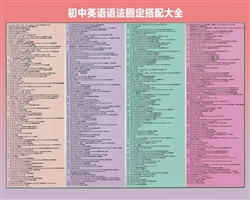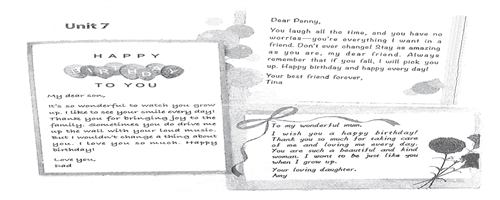一、定语
句子中修饰名词或代词的成分叫做定语。定语可以由形容词,名词,不定式,分词,动名词或从句来充当。eg:
She is a beautiful girl. (形容词)
I met someone funny on my way to Beijing. (形容词)(修饰不定代词的定语后置)
He is an English teacher. (名词)
(名词作定语时一般用单数,例外的有sports, 如 a sports star)
I have a lot of work to do. (不定式)
The book written by a schoolboy is very popular now. (过去分词短语)
We can see the rising sun. (现在分词) = the sun is rising.
He is in the reading room. (动名词) = the room for reading
The boy who broke the window is Tom’s brother. (从句)
注意:
1.形容词作定语一般放在所修饰的词前面;但当形容词修饰的是something, anything, everything, nothing, someone, everyone, everybody, somewhere等不定代词时,要放在这些词的后面。
present (在场的), absent (缺席的)作定语时需要后置。 students present / absent
2. 不定式做定语通常要放在被修饰的词后。
3 分词作定语时,即可放在所修饰词前,也可放在所修饰词后
1)分词前置,单独的一个分词作定语,一般放在所修饰词前。
He is a retired worker. 他是位退休的工人
2)分词后置,分词在以下情况,放在所修饰词的后面
a) 分词词组; There was a girl sitting there. 有个女孩坐在那里
个别分词如given, left;
This is the question given. 这是所给的问题
b) 修饰不定代词 something等
There is nothing interesting. 没有有趣的东西
c) 过去分词作定语与其修饰的词是被动关系,相当于一个被动语态的定语从句。
Most of the people invited to the party were famous scientists.
= Most of the people who were invited to the party were from South Africa
二、定语从句(Attributive Clauses)
在句中做定语,修饰一个名词或代词,被修饰的名词,词组或代词即先行词。定语从句通常出现在先行词之后,由关系词(关系代词或关系副词)引出。
关系代词有:who, whom, whose, that, which等。
关系副词有:when, where, why等。
I like the books that are written by Mr. Green.
先行词 关系词
A. 关系词:
关系词通常有三个作用:引导定语从句,指代先行词,在定语从句中充当句子成分。
关系词类别
关系词
先行词
充当从句中的句子成分
关系代词
who
人
主、宾、表
whom
人
宾
which
物
主、宾、表
that
人或物
主、宾、表
as
人或物
主、宾、表
whose
人或物
定
关系副词
when
时间
状
where
地点
状
why
reason原因
状
三、定语从句语法详解:
Anyone who breaks the law will surely be punished.
1. 先行词指人时,定语从句的引导词:
(1)指人时,who和that都可以使用.
(2)who和whom都可以作定语从句宾语,但从句中的介词提前时,不能用who.
He is the man who / whom I talked to you about.
= He is the man about whom I talked to you.
(3)先行词是人时,只用who, 不用或少用that的情况:
A. 当先行词是one, ones, anyone时,引导定语从句的关系词一般只用who,
不用that如果先行词是someone, 也可用that
The ones who tell lies won’t gain others’ trust.
Anyone who saw the accident should phone the police.
Someone who / that claims to be your uncle wants to see you.
B. 先行词是those时,关系代词一般用who不用that
Those who don’t wish to go need not go.
C. There be 句型中,修饰人的定语从句的关系代词一般只用who来引导
There is a certain old man in the village who none of us likes.
D. 若一个句子中有两个定语从句,第一个已用that, 则第二个一般用who
The man that is talking with our teacher is the professor who gave us a report yesterday.
E. 当定语从句与先行词较远时,引导定语从句的关系代词一般只用who
I came across my first teacher in the store yesterday who was still beautiful.
f 非限定性定语从句只用who来引导, 不用that
He has a son, who is a doctor.
(4)当先行词是人,只用that不用who的情况:
A. 以who开头的特殊疑问句,定语从句的先行词如是人,关系代词只用
that不用who
Who is the girl that said hello to you just now?
B. 当先行词既有人也有物时,定语从句只用that来引导
They offer talk about the person things that they remember.
C. 当关系代词在定语从句中作表语时,只用that来引导
He’s changed. He is not the man that he was.
D. 当先行词被形容词的最高级修饰时,只用that.
This is the most beautiful lady that I have ever met.
E. 当先行词是other时,定语从句只用that 引导。
You can ask the old man or any other that was there at the time.
2. 先行词是物时that 和which一般可以互换使用,但有时不可换用。
(1) 下列场合一般用that:
A. 先行词是all, much, anything, something, nothing, everything, little, the
one, none等不定代词
We should do all that is useful to the people.
The little that I have seen of his work is satisfactory.
B. 先行词被序数词,形容词最高级以及first, last, any, only, few, much, no,
some, very等词修饰
The first book that I bought in this bookstore is a dictionary.
The last person that I talked with in London is my girlfriend
The best teacher that I have ever met has gone abroad
You can take any seat that is vacant.
C. 先行词有两个:一个指人,另一个指物
I miss all the people places that we visited last summer
D. 主句是以who或which开头的特殊疑问句。
E. There be 句型中:There is a seat in the corner that is free.
F. 先行词为数词时:
Three buildings have been completed, but there are two that are still under construction.
(2) 下列场合不能用that
A. 在非限定性定语从句中,即逗号后的定语从句不用that引导,指人时用
who或whom, 指物时用which.
B. 在“介词+ 关系代词”结构中不用that, 指人时用whom, 指物时用which.
This is the book about which we are talking.
C. 先行词为that, those时,关系词用which指物,who指人
What’s that which you have got in your hand?
D. 两个定语从句,一个用了that, 另一个则用which.
Let me show you the novel that I borrowed from the library which was newly open to us.
E. 关系代词后有插入语时,只用which
Here are some stamps which – I think – you can take away.
3. 当关系词在从句中作宾语时,关系词可以省略。
4. 当先行词指时间,地点,原因(the reason)时,且关系词在从句中作状语,用when, where, why。如果关系词在从句中作主语,表语或宾语,则用that 或 which.
I want to visit the place where my mother was born.
= I want to visit the place in which my mother was born.
I still remember the years when I studied in the middle school.
= I still remember the years in which I studied in the middle school.
I don’t know the reason why he didn’t agree with us.
= I didn’t know the reason for which he didn’t agree with us.
5. 当先行词是the way, 并且关系词在从句中作方式状语时,可以用that, in which引导,也可省略。当先行词是time, time 当“次数”讲时,用that引导定语从句,且that可以省略; 当time表示“一段时间,时间”讲时,定语从句用when或at / during which引导:
I don’t like the way (that / in which) he talked to his mother.
I can hardly remember how many times (that) I’ve failed.
I’ll never forget the time when / at which we visited your hometown.
6. 当先行词family, class, team, army, company等被当作单数时,定语从句中用which,被当作复数时,用who或whom.
The family, which is a large rich one, was poor.
The party, who are all children, have lost their way.
7. 当先行词是动物时,定语从句一般用which
The dog, which he had kept for five years, was killed by someone yesterday.
A.“介词 + which / whom”引导的定语从句
关系代词在定语从句中作介词的宾语时,常常将介词前置于作宾语的关系词前,I love the music that I can dance to.
= I love the music to which I can dance.
The man who I talked to just now is my brother.
= The man to whom I talked just now is my brother.
介词后面的关系词指人时只用whom, 不能用who或that; 指物时只用which,不能用that. 注意,并非所有情况下介词都可以前移,含有介词的短语动词不可拆开,介词仍需放在动词后面,如:look for, look after, take care of等。
“介词+ which / whom”前还可以用some, any, none, all, both, neither, many, most, each, few等代词,名词或数词等。
His sons, both of whom loved music very much, spent most of their money on CDs.
The house, the roof of which is blue, will be used as a library.
B. 非限定性定语从句
非限定性定语从句和主句的关系不密切,去掉定语从句,句子的意思仍然完整,形式上用逗号把主句和从句分开,使用时注意以下几点:
1、非限定性定语从句不能用that引导
2、非限定性定语从句中的关系词不能省略。
C.as引导的定语从句的用法
1. as可引导限定性定语从句,用于such…as…., so….as…., the same….as…结构中。
He bought me such a watch as was advertised in the newspaper.
注意:比较 the same… as…. 和 the same… that….
He bought me the same watch as I lost last week.他买了一块和我上星期丢的一样的表。(一样,不是同一个)
He bought me the same watch that I lost last week. 他把我上星期丢的那块表又买回来了。(同一个)
2. 当非限定性定语从句的先行词不是主句中的某一个词,而是整个主句时,可以用which 或as引导。
D.在以下情况下用as引导:
a. 从句意思为“正如/正像...一样”
b. 从句位于句首,构成以下结构:
as is well known 众所周知 as often happens 这种情况经常发生
as is often the case 情况经常这样 as is supposed 如所预料的一样
as has been pointed out 如所指出的 as has been said before 如前所说
在下面情况经常用which引导:主句和从句表示因果关系。
He lost the game, which made us very disappointed.
非限定性定语从句是否定意义。He gained a big fortune, which meant nothing to him.
E.其他:
1. 分隔定语从句:定语从句与先行词之间被其他成分分隔开来,这种定语从句叫做分隔定语从句,此时须注意辨别从句的先行词。
The days are gone when we suffered so much.
The boss of the company, whose name was Mr. Joe, told the story.
2. 定语从句的谓语与先行词保持人称和数的一致。
注意:先行词前有one of 修饰,定语从句的谓语用复数;(not the only one of… = one of…)先行词前有the (only) one of 修饰时,定语从句的谓语用单数。





 。
。